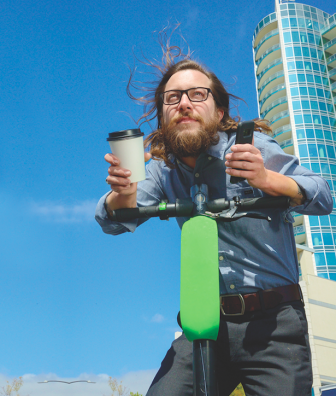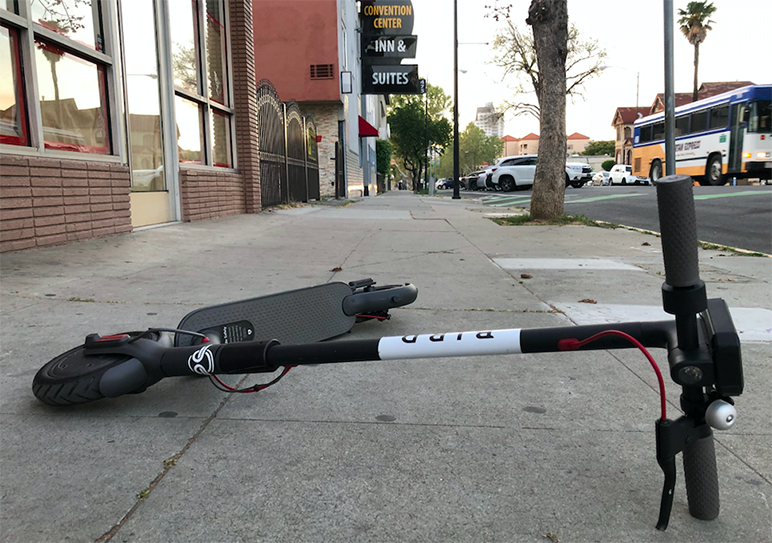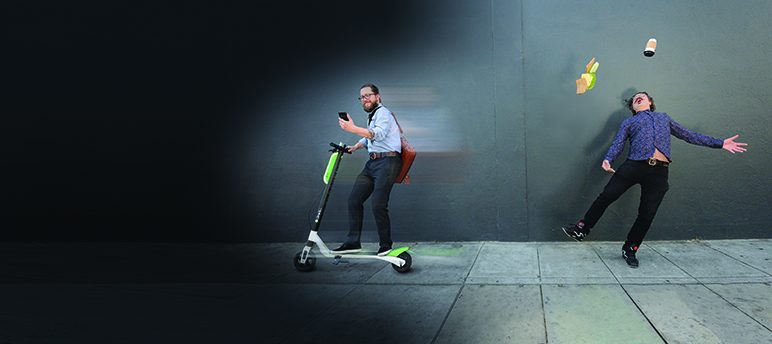Joape Pela isn’t your average, lanky tech bro. Sure, the 30-year-old East Palo Alto native lives in downtown San Jose and works as a payment analyst at local startup Finxera. But the former University of Utah football player’s 6-foot-3, 320-pound stature made him wary of one trend quickly gaining traction with his startup brethren: electric scooters.
“I was surprised. They have some jump,” Pela says of the devices that started to appear on city streets this past February. “It felt pretty good, having the wind blow through my hair and all that.”
Pela is one of many San Jose residents, commuters and business owners navigating the sudden emergence of hundreds of scooters available through two deep-pocketed app providers. San Mateo startup Lime has raised $132 million to offer on-demand shared bikes and scooters in San Jose and more than 50 other cities nationwide. Bird, a startup based in Santa Monica, is backed by $115 million and focused solely on e-scooters.
New riders can set up an account in minutes by downloading the free app, uploading a credit card and agreeing to terms of service that include parking out of the public right of way and wearing a helmet. Bird also requires users to scan a valid driver’s license. From there, users who pay a flat $1 fee, plus 15 cents per mile, can use the app’s map feature to find an available scooter and take a picture of a QR code to unlock the device.
The scooters, controlled by a simple hand throttle and brake, can reach a speed of 15 mph and hold a charge that lasts up to 18 miles. In San Jose, a city known for a lack of fast transit options, the scooters alternately attract praise from loyal users, ire for clogging public sidewalks, skepticism about safety and criticism as a perceived harbinger of gentrification—controversies that also surround sharing economy services such as Uber, Lyft and ever-evolving local bikeshare programs.
The trick with scooters: They’re just obscure enough to make them harder to regulate.
“There was no coordinated strategy for introducing the scooters to the street,” says Colin Heyne, a spokesman for the San Jose Department of Transportation. “Not surprisingly, we didn’t have a policy around e-scooters.”
Concerns the city has heard mostly include illegally riding scooters down sidewalks, users discarding scooters on lawns at the end of the ride and riders not wearing helmets. As a result, scooters have emerged as the latest uniquely 21st Century question of where a company’s responsibility ends and a city’s or consumer’s begins.
“Riders are required to obey the law, but enforcement is difficult for us,” says Sam Dreiman, Lime’s director of strategic development for California. “In some ways, it’s an even bigger question of how much we can enforce or should enforce.”
If companies try to dodge enforcement responsibility, though, it’s not clear whether the city is ready to step in.
“San Jose is one of the least-staffed cities in the country,” Heyne says. “We don’t have people waiting around to go enforce rules for errant scooters.”
In the meantime, both the state and the city are hashing out first-ever attempts at regulations designed specifically for e-scooters. In San Jose, they’re due in September, which could make for a long summer in limbo for critics.
Gray Area
Take a trip to Diridon Station during rush hour, and it’s clear that commuters in Silicon Valley are already seeking alternatives to the region’s decades-old mass transit systems. From foldable bikes and electric skateboards to the occasional pair of in-line skates or old-fashioned Razor scooters, long commutes and already-overflowing BART and Caltrain cars have pushed the non-car-dependent to get creative.

Some see the new e-scooters as techie-mobiles, others as the future of personal transportation. (Photo by Greg Ramar)
In some ways, Silicon Valley is late to the party that planning wonks refer to as “multimodal urban mobility,” where future transportation systems stand to encompass more options than 20th-century cars, trains and buses.
Fast-growing cities in China, for example, have already spent the better part of the last decade trying to figure out how electric scooters of varying sizes can coexist with electric bicycles and other car alternatives. Automakers like Hyundai and Toyota have unveiled their own high-tech scooter prototypes in recent years, and Lyft in late May signaled an interest in rolling out e-scooters in San Francisco.
“It’s just very costly to use cars to make short trips, especially in cities,” says Ratna Amin, transportation policy director for Bay Area urban planning think tank SPUR. The rise of scooters and other smaller-scale alternatives, she says, “require us to now think differently about our streets.”
For the past several months, scooters have been a touchy subject in San Francisco, pushing the city late last month to set a June 4 deadline for getting unpermitted devices off city sidewalks. The city says it will begin issuing permits at the end of the month, leaving a gap for users already reliant on the service.
In the meantime, e-scooters’ more recent arrival in San Jose has been marked by a wide range of reactions.
“Bros are racing app rental electric scooters outside my apartment,” San Jose Sharks digital media coordinator Ann Frazier wrote on Twitter. “This is now normal everyday life in downtown.”
“Someone brought their Lime scooter into a bathroom stall!?” tweeted San Jose State University student Monica Mallon.
“Fucking scooter idiots almost ran into me twice,” media pundit and City University of New York professor Jeff Jarvis complained on Twitter during a recent trip to San Jose.
Dueling opinions between people who either love or love to make fun of the service surfaced almost as fast as the scooters themselves.
In San Jose, Lime scooters were the first to appear, in late winter, Heyne says. The company was already familiar to the city after setting up a short-lived bikeshare system disbanded due to violating a non-compete clause of the city’s contract with Ford’s GoBike program. Scooters were a brief topic of discussion before the company decided to move ahead, in parallel with shared electric bikes that don’t compete with Ford’s conventional bikes, Heyne says.
“We were seeing higher ridership with those electric products in other markets,” Dreiman says. “That allowed us to accelerate our conversations with the city.”
Soon after came Bird, which opted for same-day deployment instead of advance conversations with the cities.
“That was shorter notice,” Heyne says. “As in, we got a call that they were going to be dropped off on our streets.”
Kenneth Baer, a Washington, D.C.-based consultant for Bird, declined to detail the company’s approach to entering San Jose or other new cities. “Obviously, we have a deliberative process,” he says. “I’m not going to get into the details.”
Despite the unconventional rollout, demand has ramped up quickly for the scooters, sometimes making it difficult to find an available device near hubs like Diridon Station.
In the meantime, though, business operators like Cafe Stritch’s Maxwell Borkenhagen say the largely unregulated devices can cause problems day to day.
Scooter Cops
Spending months crafting detailed policies just for e-scooters might seem a bit excessive. At stake, though, are much bigger questions about who’s responsible for the less-desirable side effects of the sharing economy. As venture capital-backed startups seeking rapid growth with minimal costs, that tension can come to a head in multiple ways.

The ubiquitous scooters have been a boon for Silicon Valley commuters looking to bridge that last mile or so to and from the nearest transit hub. (Illustration by Jeremiah Harada)
First and foremost, Lime contends, e-scooter companies are providing cities with a publicly accessible transportation option at no direct cost to the city. All they ask is that municipalities pay for necessary taxpayer-funded elements, like bike lanes and road maintenance.
“We provide the subsidy-free mobility,” Lime spokeswoman Emma Green says. “Cities provide the infrastructure.”
But what happens if riders violate the company’s terms of service, or laws governing riding on sidewalks, parking scooters in the right of way or not wearing a helmet?
State lawmakers are just now writing policies to govern bike lane usage for scooters. In San Jose, using traffic cops to police such low-level nuisances isn’t practical, Heyne says.
“We are woefully understaffed for traffic enforcement,” Heyne says, noting one recent tally counted just a half dozen citywide traffic cops.
Companies, too, are eager to avoid costly, on-the-ground scooter patrols.
“That’s a big one, trying to hold people accountable for how they park,” Dreiman says. He noted that Lime now requires users to submit a photo of how they park their scooter for a trip to officially end and billing to stop. The company is also considering using riders to police each other, submitting photos of other riders’ parking fails, or offering yet-undefined “incentives” for good behavior, he says.
Bird similarly includes language on its app directing riders how to park. For clear city code violations, like leaving scooters in front of handicap-accessible ramps, Baer says the company is well aware police can issue citations or even tow vehicles. To counter such concerns, Bird CEO Travis VanderZanden, who previously worked at both Uber and Lyft, earlier this year signed a “Save Our Sidewalks,” or SOS, pledge committing the company to removing scooters from sidewalks overnight, paying cities $1 per scooter per day to offset transportation infrastructure costs and limit the number of scooters to those used at least three times per day.
“Sometimes people lose the big picture when they think about what’s going on here,” Baer says. “There’s people who like it, people who don’t like it. Really, people are thirsting for a new way to get around.”
Still, safety is another moving target. In San Francisco, a Twitter account registered to Facebook product manager Dan Grover in mid-May posted a screenshot from the Lime app alongside an X-ray showing a broken wrist.
“Took a spill as they don’t handle uneven pavement well,” Grover tweeted. “Aside from broken bones, UX was good.”
Though Lime keeps records of user-reported injuries, not all get reported. Green says the company carries business insurance mandated by each city it operates in. Lime has also started a helmet distribution center in San Francisco or done occasional helmet giveaways. Bird has sent some 22,000 helmets to users who request them, Baer says.
In San Jose, Heyne says helmets and other safety rules will likely be included in the city’s September policy recommendations.
“It’s like bring your own seat belts if you’re renting a car,” Heyne says. Still, he added, injuries are also difficult for the city to track: “Nobody calls the DOT if they get into a scooter crash.”
Wheel World
After Pela got into riding scooters, he also saw a business opportunity in the technology. Going from work to his apartment in San Jose, he realized, he could also pick up a few scooters to take home and earn some extra cash.
“The wheels started turning, and I was like ‘Hmmm, how do you become a charger?’” Pela says. “That seems like some easy money.”
Another sharing economy staple evident in the model of shared scooter companies is heavy reliance on nonemployees to charge and move devices to keep up with demand. Pela recently signed up to charge for Bird, which he was told will earn him $5 to $20 per scooter charged and placed the next day in the appropriate “nest,” or location where it will be made available to users.
The large variation in pay, Pela was told, reflects the difference in the difficulty of “bird hunting.” Users have been known to take scooters inside their homes or offices, and social media posts also show scooters that will later have to be recovered from trash cans or other off-the-beaten-path locations.
GPS-tracked scooters going off the grid is usually an isolated problem, representatives for both Lime and Bird say. Lime also has an operations team that will knock on doors when needed—and another built-in last resort.
“We have alarms on all scooters and bikes that the team can set off,” Green says. “We’re able to use that as a way to get them back.”
The GPS also provides companies with large amounts of location data, which Lime says is aggregated and anonymized to protect user privacy but provide the company with trend data on how to best meet demand for scooters in different locations.
“We’re tracking the devices and their movement, not our riders,” Dreiman says.
Bird’s privacy policy also says that exact location data and trip routes are stored anonymously. Both Lime and Bird collect personal information like name, contact information and credit card number, upon registration.
Though Heyne says the city isn’t yet receiving any data from scooter providers, such information on ridership or common trip routes could prove useful in transportation planning as well. Key for the city of San Jose, which is also pursuing “smart city” initiatives related to self-driving cars and other nascent technologies, is balancing new forms of transportation with appropriate regulation.
“We’re trying to figure out ways to allow these innovations to happen on the public right of way, just to make sure they’re safe and responsible as they happen,” Heyne says.
The question now is whether the city, the companies or everyday users will be asked to bear that responsibility.

San Jose lacks the resources to run around enforcing rules for stray scooters. (Photo by Greg Ramar)


This could make BART work. Far better than Soviet style top down planning, craddle to grave Progressive sit around contemplating. Means they will be outlawed.
The City spent a lot of time, and probably some money as well, centrally planning the overweight and overpriced Ford bikes. I love how these groups (Bird and Lime) came in and proved that government is frequently very bad at gauging what the market wants or needs.
I predict the scooters will do quite well, unless the city crushes them with regulation. The scooters surely will beat those Ford bikes. Smaller footprint, easier to use, cheaper and more utility. What’s not to like?
I would not like to be stuck behind one going up to 15 mph on a city street. In many places, bikes stop up the right turn lane which exacerbates the gridlock. These would most likely do the same.
Load all the dumped scooters in your neighborhood into a pick up truck and leave them off at the dump.
Keep them out of the streets and off the sidewalks. It is too dangerous to mix the modes of transportation. Perhaps they could share with the bike lanes.
What about insurance for the damages they can cause?
The problem with that “solution” is that many lanes originally for motor vehicle traffic only now have the bike lane icon painted on them. Traffic is slow enough already without cars and buses being forced to drive behind a bicyclist going 7-10 mph or a scooter at 15 mph. At this rate, in another 10 years our street will be the same as chaotic DT Saigon.
Note a correction; the price is $1.00 to unlock and $0.15 per minute, not per mile, as noted in the article.
There are at least a couple of other things in that picture that are crying out for more attention than the abandoned scooter.
It is nice to see that helmets were sent out, but I do not see many wearing them when riding. My fear on this idea is that more people will treat it like riding a bike, but the higher speeds attained and the closer relationship they will have to vehicles (let alone poorly driven ones) will cause emergency medical room attention when they get in an accident. Guess who pays the costs if they are medically uninsured or under-insured, yes, all of us, not these companies.
Helmets, who needs helmets this is about culling the stupid from the gene pool!
Most of the teenagers I see wearing helmets while riding bicycles don’t strap them on, so they are useless in a fall or a crash. DUH! Keep culling the herd, because they breed and they vote.
The future of personal transportation in Silicon Valley:
https://www.youtube.com/watch?v=DeFFrHQxQVc
Another reason why we don’t need the California High Speed Rail.
And, speaking of life on the streets, Starbucks apparently has come up with a criteria for vetting hobos to enable Starbucks employees to decide when a hobo is good enough to be a Starbucks hobo.
Maybe, as a tiny sliver of common ground in our horribly divided society, we could apply the Starbucks hobo criteria to our borders.
We would be able to exclude at least SOME illegal immigrants.
“If they’re not good enough for Starbucks, they’re not good enough for America!”
I don’t know. Does this sound too right wing?
I see no correlation between: Starbucks-worthy-hobos and illegals, with this particular topic. One cannot blame it on just getting up, waking half-asleep, that is, unless one works the graveyard shift.
Get some rest, wipe the sleep from your eyes, and please try to wake less angry next time you comment; whether it be 5:30AM or 3:PM.
One needs two wings to fly; that’s one major problem America has: flying with one wing is not possible.
Yes, it does.
> I see no correlation between: Starbucks-worthy-hobos and illegals, with this particular topic.
You know, you’re right, Steven.
I snuck this into your mind space under false pretenses and you were tricked into assigning valuable neurons to process this.
My bad.
Maybe we can undo the damage by treating you with one of those mind erasing “neuralyzers” that were used on witnesses in “Men In Black”.